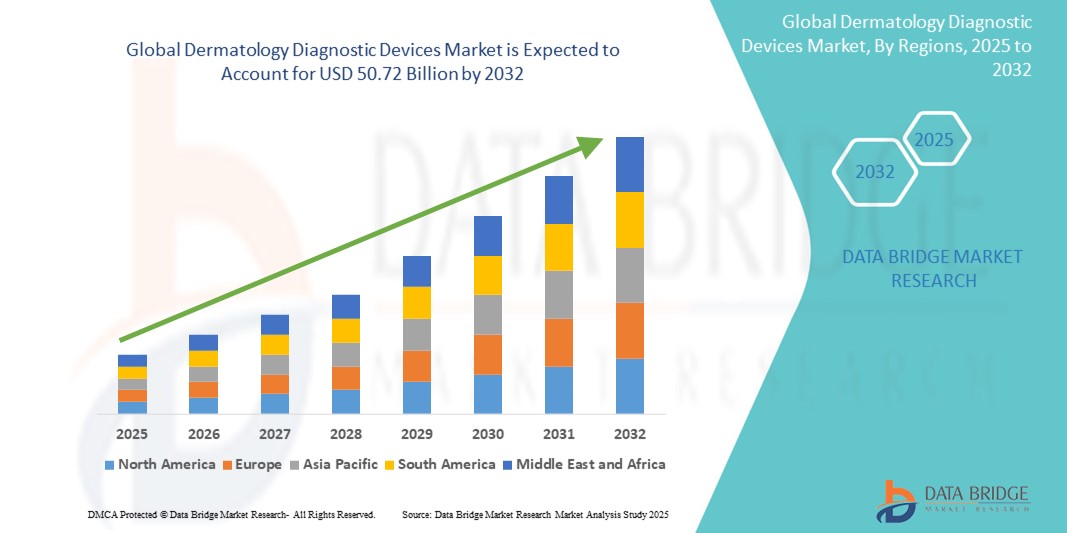Global Dermatology Diagnostic Devices Market
Tamanho do mercado em biliões de dólares
CAGR :
% 
 USD
18.94 Billion
USD
50.72 Billion
2024
2032
USD
18.94 Billion
USD
50.72 Billion
2024
2032
| 2025 –2032 | |
| USD 18.94 Billion | |
| USD 50.72 Billion | |
|
|
|
|
Global Dermatology Diagnostic Devices Market Segmentation, By Diagnostic Device (Imaging Device, Dermatoscope, and Microscope), Treatment Device (Electrosurgical, Cryotherapy, and Laser), Type (Dermatoscopes, Imaging Equipment, Microscopes and Trichoscopes, Biopsy Devices, and Others), Application (Skin Care and Others), End-User (Hospitals, Clinics, and Others) - Industry Trends and Forecast to 2032
Dermatology Diagnostic Devices Market Size
- The global Dermatology Diagnostic Devices market size was valued atUSD 18.94 billion in 2024and is expected to reachUSD 50.72 billion by 2032, at aCAGR of 13.10%during the forecast period
- This growth is driven by factors such as the increasing prevalence of skin disorders, advancements in diagnostic technologies, and the rising adoption of tele dermatology services
Dermatology Diagnostic Devices Market Analysis
- Growing consciousness among the individuals to look good in public, thereby resulting in the feeling of confidence and courage, has carved the way for the growth of innovations in the dermatology department.
- Growing number of product innovations by the major manufacturers has resulted in the availability of high grade and high quality dermatology diagnostic devices all around the globe.
- North America is expected to dominate the dermatology diagnostic devices market with 43.5% due to increasing prevalence of skin cancer and other skin diseases such as acne, eczema & rosacea and increasing adoption of cosmetic procedures are some of the major factors contributing to the growth of the market in this region
- Asia-Pacific expected to be the fastest growing region in the dermatology diagnostic devices market during the forecast period due to population growth, urbanization, and increasing disposable income and medical tourism
- Laser segment is expected to dominate the market with a market share of 79.3% due to its high prevalence and demand for precision. In addition, the launch of novel technologies in the laser device category is also attributed to the high segment growth
Report Scope and Dermatology Diagnostic Devices Market Segmentation
|
Attributes |
Dermatology Diagnostic Devices Key Market Insights |
|
Segments Covered |
|
|
Countries Covered |
North America
Europe
Asia-Pacific
Middle East and Africa
South America
|
|
Key Market Players |
|
|
Market Opportunities |
|
|
Value Added Data Infosets |
In addition to the insights on market scenarios such as market value, growth rate, segmentation, geographical coverage, and major players, the market reports curated by the Data Bridge Market Research also include in-depth expert analysis, patient epidemiology, pipeline analysis, pricing analysis, and regulatory framework. |
Dermatology Diagnostic Devices Market Trends
“Integration of Whole-Body 3D Imaging”
- The dermatology diagnostic devices market is witnessing a significant trend towards the adoption of whole-body 3D imaging systems. These advanced technologies enable comprehensive skin assessments, facilitating early detection and monitoring of skin conditions
- For Instance, In June 2023, Hoag Hospital in the U.S. introduced the VECTRA WB360, the world's first whole-body 3D photographic imaging system. This system employs 92 cameras to capture a patient's entire skin surface in less than a second, creating a 3D avatar mapping all moles and lesions with high-resolution fidelity
- The integration of AI-powered imaging software with these systems enhances diagnostic accuracy and efficiency, enabling healthcare providers to detect skin abnormalities at an early stage
- The adoption of whole-body 3D imaging is expected to drive market growth by improving patient outcomes and reducing the need for invasive procedures
- As technology continues to advance, the trend towards non-invasive, comprehensive diagnostic tools is likely to become more prevalent, shaping the future of dermatology diagnostics
Dermatology Diagnostic Devices Market Dynamics
Driver
“Increasing Incidence of Skin Cancer”
- Skin cancer, particularly melanoma, is on the rise globally. According to the American Academy of Dermatology Association, the incidence of melanoma has been increasing steadily, highlighting the need for effective diagnostic tools
- The growing prevalence of skin cancer has led to an increased demand for dermatology diagnostic devices, as early detection is crucial for effective treatment
- In response to this demand, companies are developing advanced diagnostic devices, such as AI-powered imaging systems, to improve detection accuracy and speed
- The rising incidence of skin cancer places a significant burden on healthcare systems, necessitating the development and adoption of efficient diagnostic solutions
- The increasing incidence of skin cancer is a primary driver of market growth, as healthcare providers seek advanced diagnostic tools to manage the rising number of cases
Opportunity
“Expansion in Emerging Markets”
- Emerging markets, particularly in Asia-Pacific and Latin America, present significant growth opportunities for the dermatology diagnostic devices market. These regions have large populations with increasing awareness of skin health issues
- Improving healthcare infrastructure and rising disposable incomes in these regions are facilitating the adoption of advanced diagnostic technologies
- Companies expanding their presence in emerging markets can tap into a large, underserved customer base, driving revenue growth
- Governments in emerging markets are implementing policies to enhance healthcare access, creating a favorable environment for the introduction of new diagnostic devices
- The expansion into emerging markets offers long-term growth prospects, as these regions continue to develop economically and healthcare access improves
Restraint/Challenge
“High Cost of Diagnostic Devices”
- The high cost of advanced dermatology diagnostic devices poses a significant barrier to their widespread adoption, particularly in low-resource settings
- In addition to initial costs, ongoing maintenance and operational expenses further strain budgets, limiting access to these technologies
- The cost factor exacerbates healthcare disparities, as patients in economically disadvantaged regions may not afford necessary diagnostic services
- High costs restrict the market potential, as only well-funded healthcare facilities can invest in such technologies, leaving a significant portion of the population underserved
- While technological advancements are crucial, the challenge remains to develop cost-effective solutions that can be accessible to a broader population without compromising quality
Dermatology Diagnostic Devices Market Scope
The market is segmented on the basis diagnostic device, treatment device, type, application and end-User.
|
Segmentation |
Sub-Segmentation |
|
By Diagnostic Device |
|
|
Treatment Device |
|
|
By Type |
|
|
By Application |
|
|
By End-User |
|
In 2025, the laser is projected to dominate the market with a largest share in treatment device segment
The laser segment is expected to dominate the Dermatology Diagnostic Devices market with the largest share of 79.3% in 2025 due to its high prevalence and demand for precision. In addition, the launch of novel technologies in the laser device category is also attributed to the high segment growth. This is mainly due to the availability of wide applications of dermatology treatment
The skin care is expected to account for the largest share during the forecast period in application market
In 2025, the skin care segment is expected to dominate the market with the largest market share of 11.8% due to particularly laser devices have been proved to be safer for all skin tones and hair colour and facilitate less painful treatment procedures, thereby propelling the market. A rise in demand for cosmetic laser treatments such as tattoo removal, skin resurfacing and skin tightening has significantly increased the adoption of dermatology devices.
Dermatology Diagnostic Devices Market Regional Analysis
“North America Holds the Largest Share in the Dermatology Diagnostic Devices Market”
- North America holds a dominant position in the global dermatology diagnostic devices market, with the U.S. accounting for the highest share of 43.5%
- The region exhibits an 88% adoption rate of AI-driven dermatology tools, significantly enhancing diagnostic accuracy
- Robust healthcare infrastructure and substantial investments in research and development contribute to the region's market leadership
- There is a growing preference for non-invasive and minimally invasive diagnostic technologies, reflecting an increasing focus on early detection of skin disorders
“Asia-Pacific is Projected to Register the Highest CAGR in the Dermatology Diagnostic Devices Market”
- The Asia-Pacific region is experiencing the fastest growth in the dermatology diagnostic devices market,
- There has been rise in demand for dermatology treatments, driven by increasing disposable income and medical tourism
- AI-driven dermatology tools have seen an 87% adoption rate, improving diagnostic accuracy
- The region has witnessed an expansion in cosmetic dermatology, fueled by beauty-conscious consumers
- With growing awareness of skin health, rising healthcare expenditures, and expanding healthcare infrastructure, the region is poised for continued growth in the dermatology diagnostic devices market
Dermatology Diagnostic Devices Market Share
The market competitive landscape provides details by competitor. Details included are company overview, company financials, revenue generated, market potential, investment in research and development, new market initiatives, global presence, production sites and facilities, production capacities, company strengths and weaknesses, product launch, product width and breadth, application dominance. The above data points provided are only related to the companies' focus related to market.
The Major Market Leaders Operating in the Market Are:
- Agfa-Gevaert Group(Belgium)
- Carl Zeiss AG(Germany)
- STRATA Skin Sciences(U.S.)
- Hologic, Inc. (U.S.)
- Illumina, Inc. (U.S.)
- Spindletop Capital (U.S.)
- Heine Optotechnik (Germany)
- GENERAL ELECTRIC COMPANY (U.S.)
- Koninklijke Philips N.V. (Netherlands)
- Leica Microsystems (Germany)
- Bruker (U.S.)
- Solta Medical (U.S.)
- CANDELA CORPORATION (U.S.)
- Ambicare Health (U.K.)
- Siemens Healthcare Private Limited (Germany)
- Welch Allyn (U.S.)
- CANON MEDICAL SYSTEMS CORPORATION (Japan)
- Galderma laboratories (U.S.)
- Michelson Diagnostics Inc. (U.K.)
- Canfield Scientific, Inc. (U.S.)
Latest Developments in Global Dermatology Diagnostic Devices Market
- In July 2023,Canfield Scientifichad announced the 25th World Congress of Dermatology, which was held from the 4th to the 7th of July at the Suntec Singapore Convention & Exhibition Centre. It comprised in-person demonstrations of its advanced and latest dermatology devices and solutions, including IntelliStudio, VEOS, DermaGraphix, and VECTRA WB360
- In June 2023,Hoag Hospitalin the U.S. introduced theVECTRA WB360, the world's first whole-body 3D photographic imaging system. This system employs 92 cameras to capture a patient's entire skin surface in less than a second, creating a 3D avatar mapping all moles and lesions with high-resolution fidelity
- In February 2023, Candela Corporation, a global manufacturer of medical aesthetic devices announced that the dual-wavelength Frax Pro non-ablative fractional laser platform and the Nordlys multi-application platform with Selective Waveband Technology (SWT) were licensed and made available by Health Canada.
- In January 2021,Casio Computer Co., Ltd. announced the upcoming release of the DZ-D100 DERMOCAMERA that allows close-up shots with the lens directly touching the skin as well as ordinary shots, all using a single camera.
SKU-
Obtenha acesso online ao relatório sobre a primeira nuvem de inteligência de mercado do mundo
- Painel interativo de análise de dados
- Painel de análise da empresa para oportunidades de elevado potencial de crescimento
- Acesso de analista de pesquisa para personalização e customização. consultas
- Análise da concorrência com painel interativo
- Últimas notícias, atualizações e atualizações Análise de tendências
- Aproveite o poder da análise de benchmark para um rastreio abrangente da concorrência
Metodologia de Investigação
A recolha de dados e a análise do ano base são feitas através de módulos de recolha de dados com amostras grandes. A etapa inclui a obtenção de informações de mercado ou dados relacionados através de diversas fontes e estratégias. Inclui examinar e planear antecipadamente todos os dados adquiridos no passado. Da mesma forma, envolve o exame de inconsistências de informação observadas em diferentes fontes de informação. Os dados de mercado são analisados e estimados utilizando modelos estatísticos e coerentes de mercado. Além disso, a análise da quota de mercado e a análise das principais tendências são os principais fatores de sucesso no relatório de mercado. Para saber mais, solicite uma chamada de analista ou abra a sua consulta.
A principal metodologia de investigação utilizada pela equipa de investigação do DBMR é a triangulação de dados que envolve a mineração de dados, a análise do impacto das variáveis de dados no mercado e a validação primária (especialista do setor). Os modelos de dados incluem grelha de posicionamento de fornecedores, análise da linha de tempo do mercado, visão geral e guia de mercado, grelha de posicionamento da empresa, análise de patentes, análise de preços, análise da quota de mercado da empresa, normas de medição, análise global versus regional e de participação dos fornecedores. Para saber mais sobre a metodologia de investigação, faça uma consulta para falar com os nossos especialistas do setor.
Personalização disponível
A Data Bridge Market Research é líder em investigação formativa avançada. Orgulhamo-nos de servir os nossos clientes novos e existentes com dados e análises que correspondem e atendem aos seus objetivos. O relatório pode ser personalizado para incluir análise de tendências de preços de marcas-alvo, compreensão do mercado para países adicionais (solicite a lista de países), dados de resultados de ensaios clínicos, revisão de literatura, mercado remodelado e análise de base de produtos . A análise de mercado dos concorrentes-alvo pode ser analisada desde análises baseadas em tecnologia até estratégias de carteira de mercado. Podemos adicionar quantos concorrentes necessitar de dados no formato e estilo de dados que procura. A nossa equipa de analistas também pode fornecer dados em tabelas dinâmicas de ficheiros Excel em bruto (livro de factos) ou pode ajudá-lo a criar apresentações a partir dos conjuntos de dados disponíveis no relatório.















